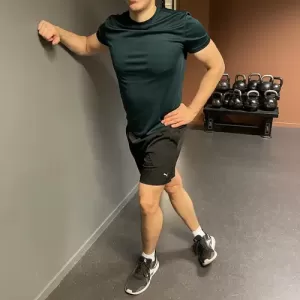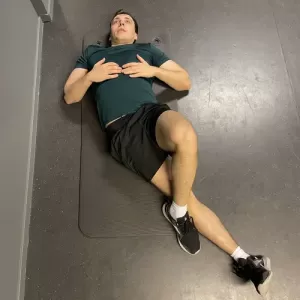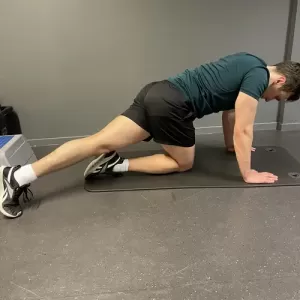Iliotibial Band Stretch: The Best Stretches for IT Band Pain
The iliotibial band (ITB) is prone to tightness and, sometimes, it can cause pain in the outer side of knee or hip joint.
Iliotibial band stretch is an easy and effective way to prevent and relieve the pain and tightness of this connective tissue.
In this article, I’ll cover the best ITB stretches for relieving the pain and tension in ITB.
What is The Iliotibial Band?
The Iliotibial Band (ITB) is a thick band of fascia (connective tissue) that runs along the outside of the thigh, from the hip to the knee.
The ITB originates at the hip bone (iliac crest) and inserts into the tibia (shin bone) just below the knee. It plays a key role in stabilizing the knee joint as you move.
The function of ITB:
- helps you to control the rotation and stability of your knee, especially during activities like running, jumping, and climbing stairs. It also works with the muscles in the hip and thigh to absorb shock and provide support as you move.
- When the ITB is healthy and flexible, it helps keep the knee moving smoothly and pain-free. But if it becomes tight or overused, it can cause pain and instability in the knee joint. That’s why it’s important to stretch ITB to keep it healthy and functioning properly.
Iliotibial Band Stretch Exercises
Here are the most effective stretches for combating iliotibial band tightness.
Standing Iliotibial Band Stretch
Starting from a standing position, place one arm on the wall and cross your legs.
Lean towards the wall with your hip while pushing with your foot in opposite direction from wall.
Hold for 30s.
Supine Iliotibial Band Stretch
Lay down on your back, and cross your legs. (see the picture below)
Push your straight leg with your foot towards your body (adduction) until you feel the stretch in your ITB.
Then, rotate your straight leg inward and hold for 30s.
Kneeling Iliotibial Band Stretch
Start from a kneeling position on your hands and knees.
Then, extend one leg and move it into adduction. Continue with rotating your leg inward.
Push with your hips toward the side of the leg you’re stretching.
Hold for 30s.
Causes of Tight ITB
Overuse of the Knee and ITB
One of the most common causes of tight ITB is overuse. Running, jumping, cycling, and other high-impact activities can put a lot of stress on the ITB, leading to tightness and pain. If you’re an athlete or you engage in these types of activities regularly, it’s important to make sure you’re stretching your ITB to prevent tightness and injury.
Weak Hip Muscles
Weak hip muscles can also contribute to tight ITB. The hip muscles are responsible for stabilizing the hip and knee joints, so if they’re weak, the ITB has to work extra hard to keep everything in place. This can lead to tightness and pain in the ITB. To prevent this, it’s important to strengthen the hip muscles along with stretching the ITB.
Poor Posture and Biomechanics
Poor posture and biomechanics can also contribute to tight ITB. For example, if you have a habit of standing with your feet turned out, your ITB has to work extra hard to keep your knee stable. This can lead to tightness and pain in the ITB. Paying attention to your posture and making sure you have proper form during exercise can help prevent ITB tightness.
Previous Knee Injury
A previous knee injury can also cause tight ITB. For example, if you’ve had a knee injury like a ligament tear or meniscus injury, the ITB may have to work extra hard to stabilize the knee, leading to tightness and pain. In this case, it’s important to work with a physical therapist to address the injury and prevent further ITB tightness.
Common Quesions About Iliotibial Band Answered
What happens if your IT band is tight?
A tight IT band can cause pain and discomfort in the knee and hip, as well as limit mobility and stability in these areas. Over time, a tight IT band can lead to knee conditions such as runner’s knee or IT band syndrome.
What causes a tight IT band?
A tight IT band can be caused by overuse, weak hip muscles, poor posture and biomechanics, and previous knee injury. Overuse of the knee and IT band can cause the muscle to become tight and develop knots, leading to pain and discomfort.
Should you massage tight IT band?
Massaging a tight IT band can help to loosen the muscle and relieve pain and discomfort. However, it’s important to seek advice from a physical therapist or medical professional before performing self-massage to avoid causing further injury.
How long does a tight IT band take to heal?
The length of time it takes for a tight IT band to heal depends on the cause and severity of the tightness. Incorporating ITB stretches and exercises into a daily routine, as well as addressing any underlying causes, can help to speed up the healing process.
Does rolling your IT band help?
Rolling your IT band with a foam roller can help to loosen and relieve tightness in the muscle. This can be an effective way to improve mobility and reduce pain and discomfort in the knee and hip.
Do squats help IT band?
Incorporating squats into your exercise routine can help to strengthen the muscles surrounding the IT band, improving stability and reducing tightness. However, it’s important to perform squats with proper form to avoid causing further injury to the IT band.
Conclusion
In this article I have covered the basics of the iliotibial band (ITB), including its anatomy, location, and role in stability and movement. I discussed the causes of tight ITB, including overuse, weak hip muscles, poor posture, and previous knee injury. I outlined effective ITB stretches, as well as tips for incorporating them into a daily routine.
Stretching and properly caring for the ITB is essential to preventing pain and discomfort in the knee and hip. Incorporating ITB stretches into a daily routine, along with addressing any underlying causes of tightness, can help to keep the muscle healthy and pain-free.
If ITB pain persists despite stretching and self-care, it’s important to seek the advice of a physical therapist or medical professional. A professional can help to diagnose the cause of the pain and develop a customized treatment plan to address the issue.
Continue reading about stretching:



